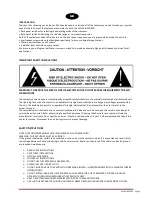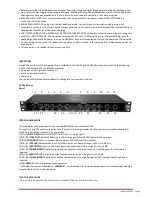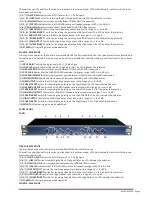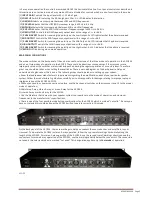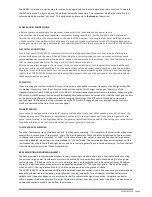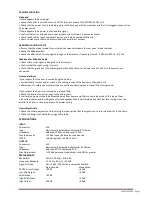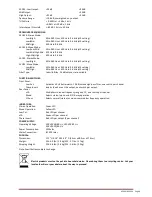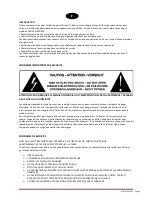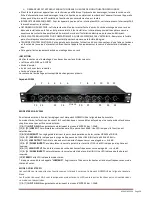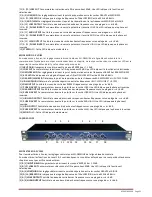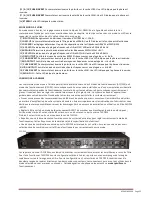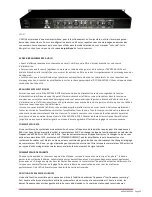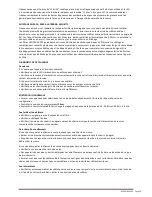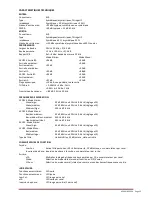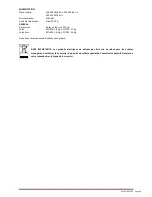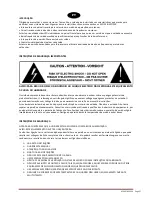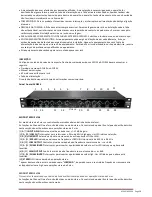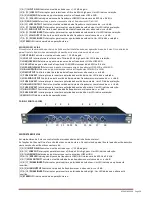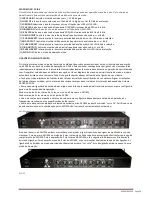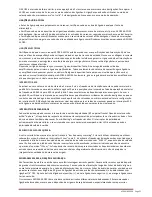
ACO23/ACO234 Page 6
The ACO23 is marked in a similar way: for stereo 2-way operation use the markings above the connectors. To operate
the ACO23 in mono 3-way mode
,
use the markings below the connectors. The connectors which are not used in the
selected mode are marked “not used”. This designation applies only to
that mode
of operation.
ACO234 AUDIO CONNECTIONS
• Before connecting anything to the crossover, make sure it is not connected to any power source.
• Be sure that the source device (equalizer, compressor, mixing console, etc.)
for the ACO234-ACO23 is turned off.
Connect the output(s) of the source device to the inputs of the crossover, following the rear panel
markings carefully.
• Make sure that the amplifiers which will be used to drive your speaker system are turned off.
Using the back panel
markings as a guide, use high quality cables to connect the amplifiers to the appropriate outputs of the ACO234
-ACO23.
ELECTRICAL CONNECTIONS
Ensure that your ACO234-ACO23 crossover conforms to the AC power specifications in your area
, by checking the
marked voltage spec on the rear of the unit. Never plug the incorrect voltage into your crossover, as this may cause
severe damage not covered under the warranty. Connect the power cord to the crossover first, then to a power source
that is properly grounded. Never lift the ground as a shock hazard may result.
After you have safely plugged in the crossover, turn on the source device(s). Turn the amplifiers’ outputs all the way
down (-
∞) and turn on the amplifiers. All of the elements of your sound system should now be on, and the amplifiers
should be turned all the way down. Turn the source device to its nominal operating level, sending a nominal (average)
level to the ACO234-ACO23. Slowly turn up the amplifiers’ outputs until you can hear signal at a comfortable volume.
Make adjustments as you desire.
X10 SWITCH
If you are using your system in stereo 2
-way or 3-
way mode, the needed crossover frequency may be higher than 960
Hz, making it necessary to set the x10 switch to the active positi
on. This changes the range of operation of the
frequency selector from 45
-
960 Hz to 450 Hz to 9.6 kHz. All other frequency selectors remain the same. When using the
X10 switch, ALWAYS ensure that the amplifiers feeding all speaker systems are turned off or
that the input gain controls
on the power amplifiers are turned down before changing the setting of the X10 switch. Not doing so may send a
spurious signal to the outputs of the crossover when the X10 switch is engaged, and may damage speaker systems
which are powered at the time of the spurious signal.
POLARITY SWITCH
Every output is equipped with a polarity (Ø) reverse switch on the front
panel. When speakers are not “in phase”, the
frequency response of the
system is compromised, particularly in the low frequencies. Out of phase
signals can also
cause “comb-
filtering” in the high frequencies. The polarity
switch is extremely useful for fine tuning your sound system
for peak performance. An LED is activated when the output polarity is reversed.
LOW FREQUENCY SUMMING
The other feature accessed on the back panel is “low frequency summing”.
This is useful with systems that utilize mono
subwoofers.
Activating the LF sum switch “sums” the low frequencies of both the left
and right inputs. The sum is sent
to channel one’s low output marked “LF
SUM”, while channel two’s low output is not used, and channel two’s
phase
invert led is disabled, indicating it is not operational in “LF Sum”
mode. The summed low frequencies represent all the
low frequencies of
both t
he left and right inputs, and since lows are generally non
-
directional anyway, it will not detract
from the true stereo picture of the source material.
RACK MOUNTING, GROUNDING & SAFETY
We have provided 4 rack screws and washers for easy mounting in standard audio racks. You should avoid mounting
the unit near large power transformers or motors. Route the AC cord away from audio lines and plug it into a power
source close by. If the power cord must cross over
audio lines, you should take care to have
them cross at 90 degree
angles. The input and output connectors are balanced/unbalanced 1/ 4” TRS type connectors. The tip of the plug is
wired as hot (+), the ring is wired
as cold (-
), and the sleeve is wired as the ground or shield.
The ACO234-ACO23 crossovers have differentially balanced input
and output circuits. Balanced wiring is recommended,
even with unbalanced
source devices, especially when running long paths. Twin
-
conductor,
shielded cable is more
reliable since it does not depend on the shield wire itself to complete the signal connection. Using twin conductor
cable,
a broken shield may only result in a slight increase in noise or hum due to the lack of shielding. You may also use
unbalanced cables to connect to and from the crossover.


